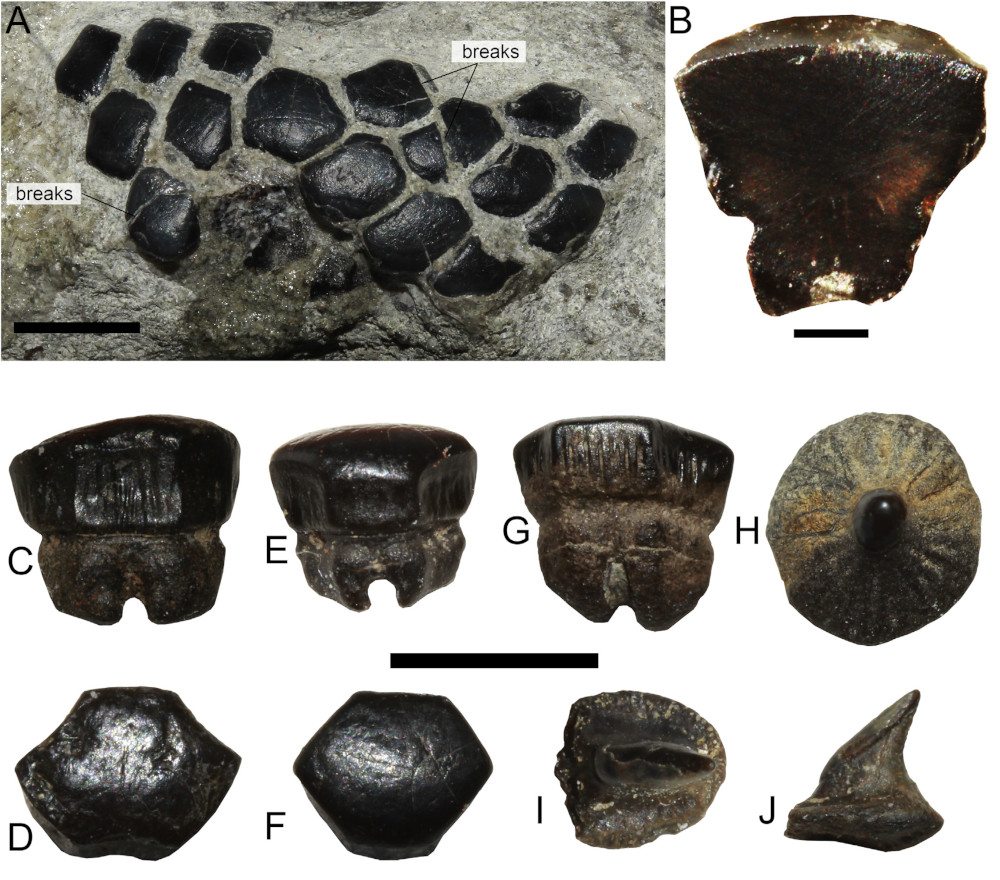Myledaphus araucanus
Otero, 2019
Classification: Elasmobranchii Rhinopristiformes Rhinobatidae
Reference of the original description
Myledaphus araucanus sp. nov. (Batomorphi, Rajiformes incertae sedis), a new Late Cretaceous ray from the austral Pacific, and first occurrence of the genus in the Southern Hemisphere. Cretaceous Research, 100, 82–90
Myledaphus araucanus sp. nov. (Batomorphi, Rajiformes incertae sedis), a new Late Cretaceous ray from the austral Pacific, and first occurrence of the genus in the Southern Hemisphere. Cretaceous Research, 100, 82–90
Description:
Citation: Myledaphus araucanus Otero, 2019: In: Database of fossil elasmobranch teeth www.shark-references.com, World Wide Web electronic publication, Version 12/2025
Please send your images of "Myledaphus araucanus" to info@shark-references.com

Myledaphus araucanus sp. nov., SGO.PV.6600, holotype. Pelluhue, central Chile. Quiriquina Formation, lower upper Maastrichtian. A, Partial, articulated tooth pavement. Diaclases are indicated for teeth which were naturally broken during the burial; B, sectioned tooth sample. SGO.PV.6598. Two associated teeth. Algarrobo, central Chile. Estratos de Quebrada Municipalidad unit, lower Maastrichtian. C, E, teeth in lateral view; D, F, teeth in occlusal view. SGO.PV.6732. One isolated tooth associated with two dermal denticles, likely referable to the same specimen. G, lateral view of the tooth; H, I, dorsal view of the dermal denticles; J, lateral view of one of the dermal denticles. Scale bar equals 5 mm in all cases except B, equals 1 mm. © Otero (2019)

Myledaphus araucanus sp. nov., SGO.PV.6600, holotype. Pelluhue, central Chile. Quiriquina Formation, lower upper Maastrichtian. A, Partial, articulated tooth pavement. Diaclases are indicated for teeth which were naturally broken during the burial; B, sectioned tooth sample. SGO.PV.6598. Two associated teeth. Algarrobo, central Chile. Estratos de Quebrada Municipalidad unit, lower Maastrichtian. C, E, teeth in lateral view; D, F, teeth in occlusal view. SGO.PV.6732. One isolated tooth associated with two dermal denticles, likely referable to the same specimen. G, lateral view of the tooth; H, I, dorsal view of the dermal denticles; J, lateral view of one of the dermal denticles. Scale bar equals 5 mm in all cases except B, equals 1 mm. © Otero (2019)
Description
Original diagnosis after Otero (2019) p. 85 [27458]: Species of Myledaphus distinguished by a soft, unornamented crown with vertical wrinkles.
Original diagnosis after Otero (2019) p. 85 [27458]: Species of Myledaphus distinguished by a soft, unornamented crown with vertical wrinkles.
References

Review of two marine vertebrate assemblages from the Arauco Basin (central Chile) reveals diversity changes throughout the Maastrichtian. Cretaceous Research, 166, Article 105996
DOI: 10.1016/j.cretres.2024.105996

Global impact and selectivity of the Cretaceous-Paleogene mass extinction among sharks, skates, and rays. Science, 379, 802–806
DOI: 10.1126/science.abn2080

Myledaphus araucanus sp. nov. (Batomorphi, Rajiformes incertae sedis), a new Late Cretaceous ray from the austral Pacific, and first occurrence of the genus in the Southern Hemisphere. Cretaceous Research, 100, 82–90
DOI: 10.1016/j.cretres.2019.03.025

Tiburones, Rayas y Quimeras (Chondrichthyes) Fósiles de Chile. Publicación Ocasional del Museo Nacional de Historia Natural, Chile, 63: 17–33
Estudio sobre muestreos paleontológicos practicados en el sector de costa comprendido entre Constitución y Pelluhue (latitudes 35 21'a 35 47') con una información adicional sobre existencia de Terciario carbonífero en Cobquecura. Informe inédito, Departamento de Geología, Universidad de Chile

Die Quiriquina-Schichten als Sediment und Paläontologisches Archiv. Palaeontographica, 73(1-6), 49–106

Review of two marine vertebrate assemblages from the Arauco Basin (central Chile) reveals diversity changes throughout the Maastrichtian. Cretaceous Research, 166, Article 105996
DOI: 10.1016/j.cretres.2024.105996

Global impact and selectivity of the Cretaceous-Paleogene mass extinction among sharks, skates, and rays. Science, 379, 802–806
DOI: 10.1126/science.abn2080

Myledaphus araucanus sp. nov. (Batomorphi, Rajiformes incertae sedis), a new Late Cretaceous ray from the austral Pacific, and first occurrence of the genus in the Southern Hemisphere. Cretaceous Research, 100, 82–90
DOI: 10.1016/j.cretres.2019.03.025

Tiburones, Rayas y Quimeras (Chondrichthyes) Fósiles de Chile. Publicación Ocasional del Museo Nacional de Historia Natural, Chile, 63: 17–33
Estudio sobre muestreos paleontológicos practicados en el sector de costa comprendido entre Constitución y Pelluhue (latitudes 35 21'a 35 47') con una información adicional sobre existencia de Terciario carbonífero en Cobquecura. Informe inédito, Departamento de Geología, Universidad de Chile

Die Quiriquina-Schichten als Sediment und Paläontologisches Archiv. Palaeontographica, 73(1-6), 49–106

















